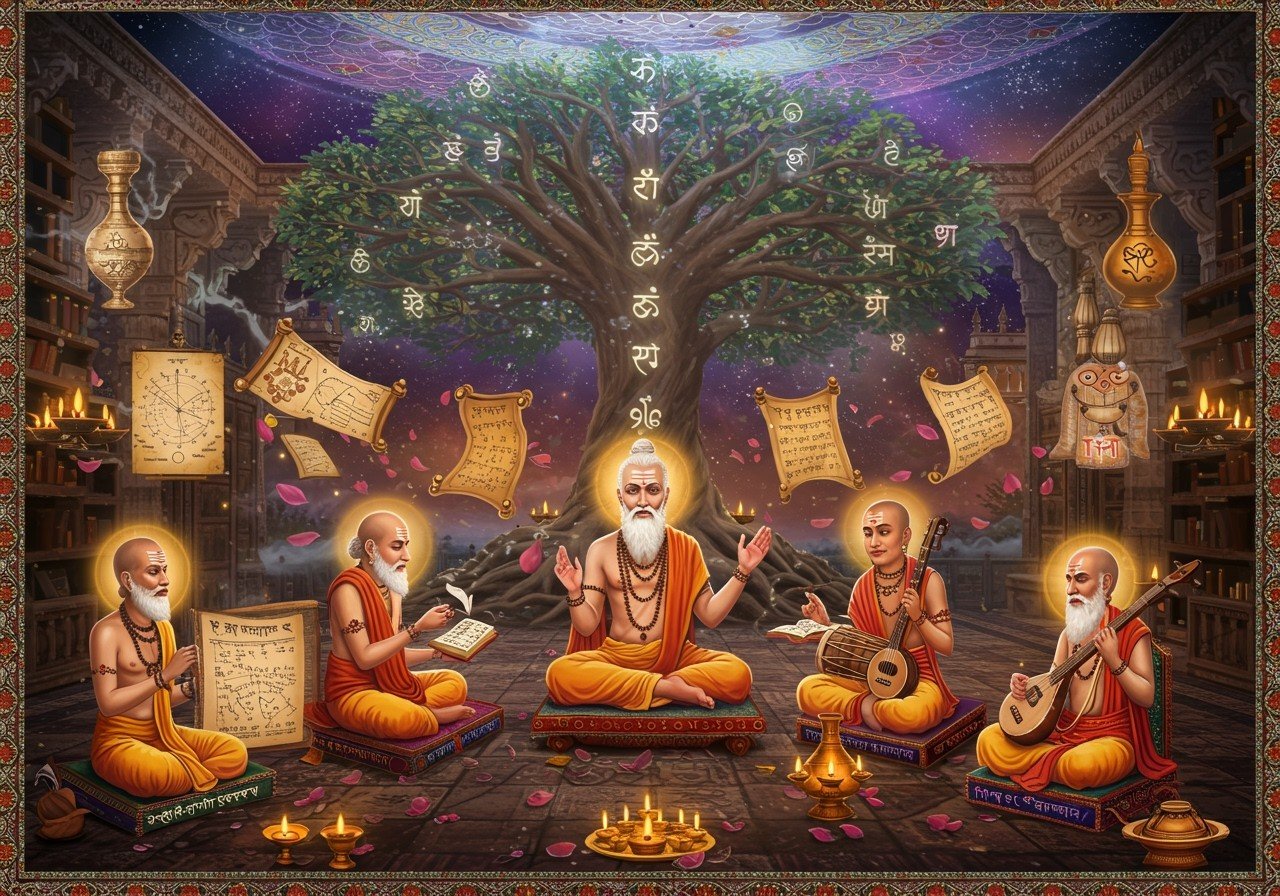
Delving into the Upavedas and Vedangas is essential for anyone seeking a deeper understanding of Vedic knowledge. This blog provides a comprehensive introduction to these vital aspects of the Vedic tradition, exploring their origins, significance, and practical applications, and how they complement the Vedas and their Brahmanas. This guide is designed for culturally aware Indians who appreciate tradition and seek authentic ritual items with the convenience of online shopping.
The Vedas: The Foundation of Hindu Philosophy
The Vedas, the oldest scriptures of Hinduism, comprise four main texts:
- Rigveda: A collection of hymns dedicated to various deities.
- Samaveda: Melodies and chants derived from the Rigveda, used in liturgical practices.
- Yajurveda: Prose mantras and formulas for rituals and sacrifices.
- Atharvaveda: Spells, charms, and incantations related to daily life and healing.
Each Veda is divided into four parts: Samhitas (hymns), Brahmanas (ritual manuals), Aranyakas (forest treatises), and Upanishads (philosophical texts). The Vedas are considered Shruti, meaning “that which is heard,” implying divine revelation passed down through generations by Vedic scholars.
Upavedas: Practical Applications of Vedic Wisdom
The Upavedas, often translated as “applied knowledge,” build upon the Vedic foundation, offering practical guidance in various fields. They are considered Smriti – remembered traditions.
- Ayurveda (Rigveda): This “science of life” focuses on holistic well-being, encompassing physical, mental, and spiritual health. Learn more about Ayurveda and its benefits in our blog post Yoga & Ayurveda: A Holistic Wellbeing Approach.
- Dhanurveda (Yajurveda): This “science of archery” deals with martial arts, warfare, and self-defense, emphasizing discipline and strategic thinking.
- Gandharvaveda (Samaveda): This “science of music” explores the arts, including music, dance, drama, and poetry, recognizing their power to uplift and inspire.
- Arthashastra (Atharvaveda): This “science of politics” focuses on statecraft, economics, and governance, providing guidelines for a just and prosperous society.
Vedangas: The Six Limbs of Vedic Knowledge
The Vedangas are six auxiliary disciplines that support the understanding and proper application of the Vedas. They are:
- Shiksha (Phonetics): Ensures accurate pronunciation and intonation of Vedic mantras, preserving the sonic integrity of the sacred texts.
- Vyakarana (Grammar): Provides the grammatical rules for Sanskrit, the language of the Vedas, enabling precise interpretation and understanding.
- Chandas (Prosody): Deals with the rhythmic patterns and meters of Vedic verses, enhancing the aesthetic and spiritual impact of the chants.
- Nirukta (Etymology): Explains the meaning and derivation of complex Vedic words, unlocking deeper layers of meaning within the texts.
- Jyotisha (Astronomy & Astrology): Determines auspicious timings for Vedic rituals and ceremonies, aligning them with cosmic energies. Explore how to align your puja with celestial energies: Aligning Your Puja with Celestial Energies.
- Kalpa (Ritual): Outlines the procedures for performing Vedic rituals and sacrifices, ensuring their efficacy and adherence to tradition.
The Brahmanas: Ritual Manuals of the Vedas
The Brahmanas are prose texts that provide detailed explanations of Vedic rituals, including their significance, procedures, and associated mantras. They serve as practical guides for priests and practitioners. For instance, the Rigveda has the Aitareya and Kaushitaki Brahmanas, while the Yajurveda is associated with the Shatapatha Brahmana. Understanding the Brahmanas is crucial for comprehending the practical aspects of Vedic worship.
The Interconnectedness of Vedic Knowledge
The Vedas, Upavedas, Vedangas, and Brahmanas form an interconnected system of knowledge. The Vedas provide the core spiritual and philosophical principles. The Upavedas apply these principles to specific areas of life. The Vedangas provide the tools and techniques for understanding and applying the Vedas. The Brahmanas detail the rituals that connect individuals with the divine.
Practical Applications in Modern Life
Despite their antiquity, the Upavedas and Vedangas hold remarkable relevance today. Ayurveda offers holistic health solutions. Dhanurveda’s principles are applied in martial arts. Gandharvaveda enriches music and dance forms. Arthashastra’s wisdom informs political science and economics. The Vedangas help preserve and transmit Vedic knowledge, ensuring the continuity of this rich tradition.
Integrating these ancient disciplines into modern life can enhance both spiritual and practical aspects of our existence. For those seeking to deepen their understanding and practice, Poojn.in offers a wide selection of authentic products and resources. Browse our collection of incense, camphor, and other puja items to enhance your spiritual practice.
Conclusion
The Upavedas and Vedangas offer a profound and nuanced understanding of Vedic wisdom. They bridge the gap between spiritual teachings and practical applications, making ancient knowledge relevant in our modern world. By exploring these texts and incorporating their teachings into our lives, we can experience the holistic benefits of Vedic wisdom and contribute to the preservation of our rich cultural heritage.


